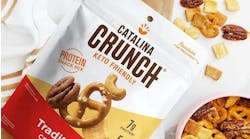The traditional idea of a “snack” is a between-meal, quick bite that satisfies an urge. But in today’s world, snacking has become much more important. According to a 2011 USDA report, adults average 2.2 snacks per day, more than double from three decades earlier.
“Consumers are living more on-the-go and snacking more frequently, and because of that they’re relying on the snack category as a source of nutrition more than before,” says David Walsh, vice president of membership and communications at SNAC International, a trade association for the snack food industry. “Because of that reliance we’re seeing a lot of innovation in that category.”
Leading innovations in snacking include exotic flavors, plant-forward products and high-protein edibles. But perhaps the overriding trend is that food manufacturers are creating more healthful snacks that taste great while fulfilling nutritional requirements.
“People are beginning to really focus on what they are putting into their bodies and looking for snacks that provide more than just calories and curb cravings,” explains nutritionist Lisa Richards, author of The Candida Diet. “This is changing the way the snack food and health food industries are formulating their products.”
Beyond granola bars
Snacks with a focus on plant-based ingredients are flying off of food processor’s drawing boards.
“We’ve seen plant-forward really top of mind for a lot of people,” notes Jada Linton, a registered dietitian and marketing and communications specialist for the National Peanut Board. “Plant-forward snacks have more fiber and more protein, and because of that they satisfy you for a longer time.”
Linton explains that balance among the oils, sugars and proteins in snacks is essential. The protein – such as from peanuts or other nuts – provides satiety; the oil helps with mouthfeel; and the sugar provides sweetness.
“We were going through so many granola bars and my kids were getting tired of them,” says Wernli. “And the granola bars had lots of unpronounceable ingredients in them, so I thought there had to be a healthier way.”
Wernli began experimenting with balls containing her company’s natural peanut butter and other natural ingredients, such as honey, maple syrup and rolled oats. Once she had a facsimile of what she wanted – and got her kids’ taste approval – she turned to food scientists to convert her homemade creation to something that could be manufactured.
“I had very strict parameters, I wanted whole ingredients and not an ingredient that has multiple ingredients within it,” Wernli says. “That made it tricky. The food scientist tested our recipe and showed us that the honey and maple syrup would crystalize on the outside – it’s called weeping – when they were taken out of the freezer and your fingers would get sticky as your eating the product.”
So Wernli turned to date paste instead. It’s still natural and acts as an excellent binder, but its sugars do not weep like those found in honey and maple syrup.The food scientist also suggested that rolled oats Wernli used on the outside of the balls be pulsed beforehand.
“That made the consistency smoother and provided a better texture,” Wernli says. “And the pulsed oats hold the shape better and are a little more chewy, which is exactly the consistency we were going for.”
Another example of a plant-forward snack is Power Veggie Bites from Appleton’s Market. The muffin-like snacks come in three varieties – Thai Sriracha, Sun-Dried Tomato Basil and Mexican Enchilada – and contain about 100 calories.
The ingredient panel is loaded with plants – such as broccoli, carrots and Swiss chard – which created challenges for the small company, says owner Christina Appleton.
“I had to find a manufacturing partner that could process fresh ingredients, bake and freeze,” Appleton says. “I was fortunate to find a food manufacturer here in California that specialized in small baked goods and had the labor and skill to make the product.”
Protein lovers
The popularity of Paleo and Keto diets in recent years has initiated another snack trend: more protein. Meat-based snacks come to mind first when consumers think of protein, but protein also can be found in plant-forward snacks.
“Higher protein inclusion is a common driver of new plant-forward product formulation,” notes Joe Colyn, business partner-procurement for JPG Resources.
Linton of the National Peanut Board echoes that sentiment. She explains that consumers seek out the plant protein to satisfy their hunger and provide an energy boost, such as before or after a workout.
“Peanuts have 7g of protein in a serving, which is more than any other nut,” Linton says. “That provides long-lasting energy and satisfies hunger.”
But meat is still a major player when it comes to protein snacks.
“We’ve seen increased sales of beef jerky and other meat snacks,” Walsh says. “Any type of protein has been resonating with consumers.”
Another meat snack category that is exploding is pork rinds, Walsh says. Manufacturers such as Utz and Rudolph’s have moved beyond the traditional salted fried pork skin.
“They are great at innovating flavors,” Walsh says. “I’ve seen Cuban mojito flavor, cilantro lime flavor and others. They’re appealing to younger consumers who are experimenting with new flavors.”
Taste forward
“If a snack doesn’t taste good, it doesn’t matter how healthy it is, people won’t buy it,” Walsh says. “Especially younger consumers are looking for more adventurous flavors and experiences.”
Mark Zoske, CEO of SaltWorks, confirms Walsh’s assessment. “We’re seeing growing popularity toward international flavors, savory, spicy, smoky and umami flavors – or a combination of these flavor profiles with traditionally sweet products, like sea salt caramels or smoked almond toffee,” Zoske says.
Walsh notes that bold, spicy flavors – the hotter the better – are popular today. One example is Spicy Peri Peri Biltong Sticks from Stryve. This beef stick snack also meets the clean-label trend, as all of its ingredients are common foodstuffs: beef, vinegar, salt, chile pepper, coriander, black pepper, nutmeg, clove and lamb casing.
“Satisfy your heat tooth with the stinging bite of our Spicy Peri Peri biltong sticks,” Stryve’s web site boasts. “If you like a hotter pepper, and don't mind a little face sweat, the ‘African Red Devil’ is the pepper for you. It's the perfect balance of nice-and-hot without the taste bud blowout.”
The manufacturing process of extruded snacks such as “puffs” is ideal for combining adventurous flavors with healthy ingredients, Walsh says. Because the ingredients are thoroughly combined prior to the extrusion process, a wide variety of ingredients can be incorporated.
The same goes for veggie chips made from ground dehydrated vegetables – it’s simple to add flavor at the mixing stage.
Consider Snacklins, a new “puffy” chip made with yuca, mushrooms and onions. The chips, which the manufacturers tout as “vegan pork rinds,” have a simple ingredient panel: yuca, mushroom, sunflower oil, spice, onion and sea salt, for example, for their barbeque flavor.
“Those types of product are very adaptable regarding incorporating a lot of ingredients, like pea proteins, lentils and pulses,” Walsh says. “And they are good for experimenting with flavors because it’s all about the seasoning. It’s pretty easy to get creative, even if it’s a healthier product.”
Another category that can combine strong flavors with a vegetable-forward base is the veggie crisp or chip made from sliced whole vegetables, such as Terra Real Vegetable Chips.
A new product in that category that Walsh recently noticed is Barnana Plantain Chips. These chips come in four varieties – Pink Salt, Acapulco Lime, Spicy Mango Salsa and Sea Salt and Vinegar – and all start with organic plantain slices as their base. It’s simple to add the flavors after the chips are fried.
Some companies push the vegetable-forward concept further by incorporating a variety of veggie chips in one package.
“You can incorporate ancient grains, cauliflower, flax seeds, seaweeds and different veggies, all in the same pack and really tout it to the consumer,” Walsh says.
For many snacks, the key flavor enhancer is salt. SaltWorks recently added Pacific Blue Micro Flake and Mini Flake sea salts, which are designed with a larger surface area than more traditional granular salt to adhere to foods better and offer enhanced flavor impact.
“Because of this, not only do they offer a clean, sea salt-forward flavor, but incorporating them into snack food products may also help naturally reduce sodium, making them ideal for brands aiming for lower sodium content,” Zoske explains.
“Micro Flake is comprised of superfine sea salt flakes (similar to a powdery texture) made to evenly coat snacks like popcorn, potato chips, and nuts, delivering delicious, crisp sea salt flavor. Mini Flake has a light and crunchy texture that’s perfect on french fries, pretzels and crackers. It’s made to cling tightly, so that more of the sea salt hits the palate instead of falling to the bottom of the bag. Both varieties offer the superior clean, crisp taste of all-natural sea salt with no additives.”
The trend of healthy – but flavorful – snack formulations is here to stay.
“People are more health-conscious than ever, yet they do not wish to settle for a bland rice cake or a saltine,” says Vinay Amin, CEO of EU Natural. “People are looking for a balance or a middle-of-the-road option. They are willing to compromise but not completely give up what makes eating feel good.”


